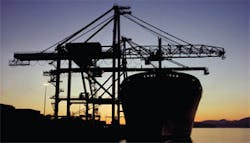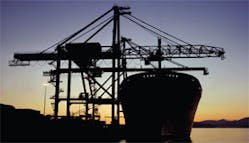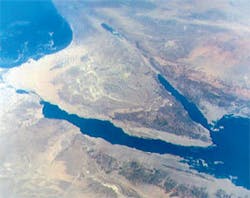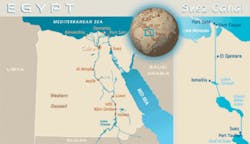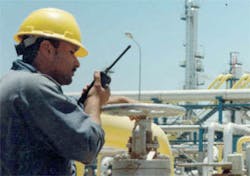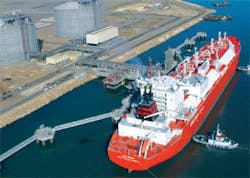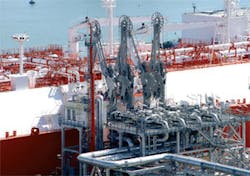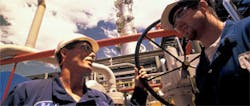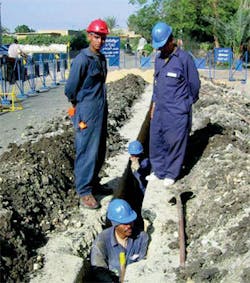When the idea of linking the Mediterranean Sea and the Red Sea with a navigable waterway first occurred to the Pharaohs, the commercial world was a far smaller place. As trade expanded over the centuries, so did the value of a route that would connect Europe, the Middle East, Africa and Asia that did not require a long trip around the southern tip of Africa.
Turning that ancient idea into today’s reality took centuries and claimed many lives before Egypt’s Suez Canal was finally inaugurated in 1869. But it now is one of the world’s most strategic trade routes, shortening the distance between most of the world’s markets.
At the heart of international trade and commerce, Egypt today can competitively supply a market of one billion people.
As important as the Canal became to moving goods from source to consumer, however, the growing importance to the world of Middle Eastern oil called for additional capacity and a different kind of transportation facility.
That need was met by the 320-km Suez Mediterranean (Sumed) pipeline system linking Ain Sukhna on the Gulf of Suez to Sidi Kerir on the Mediterranean. Sumed’s twin parallel 42-in. pipelines, with a design capacity of 117 million tons/year, has been in operation since 1977 as a companion to the Suez Canal for transporting oil from the Arabian Gulf region to the Mediterranean.
Through 2004, it had transported more than 16 billion bbl.
A regional alliance, Sumed is owned by EGPC, 50%; Saudi Arabian Oil Co., 15%; three Kuwait firms, 15%; the International Petroleum Investment Co. IPIC (Abu Dhabi), 15%; and Qatar Petroleum Corp., 5%.
The pipeline system is part of the local and international long-term political vision that has remained unchanged since the presidency of Gamal Abdel-Nasser.
Suez Canal: Improvement continues
The Pharaohs dug a canal linking the Mediterranean and the Red Sea through the eastern branch of the Nile Delta but it remained neglected. The Greeks, then the Romans dug it several times, but it was again neglected. Dug once again at the time of the Arab conquest of Egypt, the Canal existed for a time, but was later filled up.
The enduring idea was finally set on the path to reality in 1854 when French engineer Ferdinand De-lesseps signed an agreement with the Egyptian Government to dig the Canal. Digging began in 1859, coincidentally the year that the first commercial oil well was drilled in the US. For 10 years, more than 2.4 million Egyptian workers worked on the Canal; more than 125,000 lost their lives.
In 1869, the Suez Canal was finally opened for navigation. In July 1956, Egypt nationalized the Canal after it had been an international company for 87 years.
With a total length of 192 km, Suez remains the world’s longest canal without locks. Today, it transports 14% of total world trade, 26% of oil exports and 41% of the total volume of goods and cargo that reach Arabian Gulf ports. It can handle about 25,000 vessels annually.
About 3,300 oil tankers passed through the Suez Canal in 2004, a 20% increase in tanker traffic from 2003. Total northbound and southbound oil shipments increased from 1.4 to 1.7 million b/d between 2003 and 2004. Transit in the Canal employs a convoy system. The northbound convoy consists of two groups and southbound traffic includes two convoys.
There are no length restrictions for ships traversing the Canal. Currently, the Canal can accommodate ‘Suezmax’ class tankers with drafts to 62 ft and 200,000 dead-weight-ton (dwt) maximum cargos. Depending on the type of vessel and its load, speed is limited to 11-16 km/hr; an average transit time is about 14 hours.
In 2001, the Suez Canal Authority (SCA) launched a 5-year program to reduce average tanker transit times to 11 hours. The SCA also is moving ahead with a 10-year project to widen and deepen the Canal. By 2010, it will be able to accommodate very large crude carrier (VLCC) and ultra large crude carrier (ULCC) class tankers with oil cargos of up to 350,000 dwt.
Sumed: Stable, economical, flexible
The Sumed system includes the terminal at Ain Sukhna where up to four tankers of any size can discharge their cargo simultaneously. At the other end of the pipeline, Sidi Kerir terminal can load five tankers of up to 400,000 dwt at the same time. Large tank farms at each terminal provide spare storage capacity and pipeline operating flexibility that helps meet customers’ varied requirements.
Original capacity of the Sumed system was about 1.6 million b/d. It has grown to about 2.4 million b/d currently and is operating at about 96% of design capacity, said Eng.
Moustafa Gomaa, Chairman of Arab Petroleum Pipelines Co. Future capacity increases will depend on crude oil market conditions, he said.
As political tensions grow, Egypt’s access to the Mediterranean for Middle East oil becomes increasingly valuable.
“This is especially true since Sidi Kerir has become one of the important storage areas in the Mediterranean,” said Eng. Gomaa. “As we keep the Sumed pipeline the safest route to the Mediterranean, it also provides continuous stability for oil flow from the Arabian Gulf countries to Europe.”
From the Mediterranean, oil can reach southern Europe in three days and northern Europe in seven days. The pipeline system can help deliver Arabian Gulf crude to European refineries 15-22 days earlier than a tanker making the journey around Africa’s Cape of Good Hope.
“Regardless of the situation, Sumed has proved that it is the most economical way to move crude from the Arabian Gulf to Europe,” said Eng. Gomaa.
In 2004, about 65% of deliveries to Ain Sukhna came from Saudi Arabia, 24% from Iran, 6% from Egypt, 4% from Kuwait. About 35% of the crude lifted from Sidi Kerir during the year went to the eastern Mediterranean, 26% to the western Mediterranean, 34% to northwest Europe and 5% to the US.
Adequate storage and pumping capacity are keys to the flexibility of the Sumed system. Fifteen double deck floating roof storage tanks at Ain Sukhna terminal have a total capacity of 1.5 million cubic meters (cu m). Two pumping stationsone for each pipelinecan each pump at rates to 9,300 cu m/hour. A boosting station at Dahshour is equipped with six pumps.
Sidi Kerir has 24 floating roof tanks with a total capacity of 2.6 million cu m. Five pump stations load crude, each connected to one group of tanks. The de-ballasting plant at the terminal treats ballast water, delivering clean water with less than 10 parts per million (ppm) dissolved solids into the Mediterranean.
Operating in batch mode, the Sumed system is controlled and monitored by a sophisticated integrated supervisory control and data acquisition (Scada) system at the dispatching center at Ain Sukhna. Backup control at Dahshour provides redundancy and local control centers are part of the system.
“Our main objective is to assure the customers of Sumed that their products are in safe hands,” said Eng. Gomaa. “We strive to do this in the most economical, and with minimum environmental impact.”
More than just a transporter
Oil transportation is not the only service Sumed provides. It also helps companies market their crude from Sidi Kerir, which can serve as a stable strategic focal point for sale of oil on a free-on-board (FOB) basis. Shippers discharging a VLCC or ULCC at Ain Sukhna terminal, for example, can tailor liftings from Sidi Kerir in the volumes and types needed by their refineries, FOB customers, or to meet destination port limitations.
This ‘cargo tailoring’ lowers freight costs and provides flexibility.
Other related services include:
- Stock transfer of crude oil while in Sumed custody
- Cargo topping, a process that avoids dead freight by advancing the balance when a customer’s crude type in Sumed custody is less than the tanker size
- Crude oil swap to clear small amounts of a customer’s remaining inventory
- Methods to facilitate financial transactions
Innovation has helped the system keep pace with larger vessels and volumes and shifting supplies and markets. Sumed is cooperating with the Suez Canal Authority, for example, on a system of lightering called drop and pick, which was established in 1997. The process makes it possible for a VLCC to be partially unloaded at Sumed’s terminal at Ain-Sukhna so the tanker can pass through the Canal safely and reload at Sidi Kerir terminal.
Making it possible for VLCCs to use the Canal, although they cannot transit it fully loaded because of the draft limitation, allows the Sumed/Canal partnership to serve the east coast of North America, as well as other markets.
“This technique has increased our capacity and we hope more users will take advantage of this option,” said Eng. Gomaa.
Another project was launched recently to receive Mediterranean and Black Sea crudes at Sidi Kerir terminal for storage and reloading. Growth of Mediterranean, Russian and Caspian exports prompted Sumed to modify two single buoy mooring (SBM) facilities to be able to receive crude at Sidi Kerir and reload it again.
Storage at Side Kerir provides a buffer to Mediterranean refineries, minimizing their need to invest in storage or maintain large inventories. VLCC cargoes can be accumulated to save freight for the long-haul US-bound cargoes. And Mediterranean crude can be combined with Arabian Gulf crude transported through the pipeline.
Three new tanks with a total capacity of 1.2 million bbl were added to enhance the flexibility of this ‘back loading’ option.
Another change under consideration is the ability to pump crude from North to South to handle potential exports from the CIS and North Africa to Asia.
“The Sumed pipeline is also very important to the Midor refinery,” said Mr. Mahmoud Nazeem, Midor Chairman. Midor currently has an agreement with Saudi Arabia under which almost half of the refinery’s crude diet is met with the Saudi crude. That oil must be transported from the receiving port on the Red Sea to Sidi Kerir on the Mediterranean where the other terminal of the refinery’s crude supply pipeline is located. Sumed has installed special import facilities at Sidi Kerir to receive Mediterranean crude for Midor.
A community partner
Since it began, part of Sumed’s net profit has gone to community development, including the support of many universities and health care facilities in both Suez and Alexandria.
It introduced an up-to-date ultrasonic scanning medical device in the Alexandrian government hospitals, and has financed many facilities for the handicapped in Egypt. The company also focuses on the development of its employees by offering training courses and a health care program for employees and their families.
Environmental protection has also been an ongoing effort. In the mid 1970s, Sumed spent $40 million to build its plant to treat ballast water from tankers. Sumed management continues to be committed to preventing pollution. Along with the ballast water treatment facility, a key part of that effort is the system’s sophisticated continuous monitoring capability that provides early warning of any incident. Strategically placed pollution fighting equipment uses the latest technology.
“We also are working under the umbrella of the Ministry of Petroleum and Alexandria University to support research in the industry and to forge a solid link between the university and the industry,” said Eng. Gomaa.
Other key pipeline projects
Critical to Egypt’s oil and gas strategy are natural gas exports, both by pipeline and as LNG.
The first phase of the Arab Natural Gas Transmission Pipeline, a regional system to serve neighboring countries, was inaugurated in mid 2003. A second phase came on stream at the end of last year. Further expansion is planned to connect Syria and Lebanon, as well as the European gas network through Turkey.
In early 2006, Egyptian Petroleum Minister Fahmy and Turkish Minister of Energy, Helmi Guler, agreed to establish an Egyptian-Turkish company to extend the Arab Gas Pipeline to the Syrian-Turkish border and market gas to Europe.
The first phase of the Arab Natural Gas Transmission Pipeline system, mostly onshore, was completed in 18 months. It connects Al Arish, Egypt to Aqaba in southern Jordan via Taba with a 350-km 36-in. pipeline. The second phase of the system, the Jordanian Gas Transmission Pipeline, extends from Aqaba north 370 km to Rehab, Jordan, also with a 36-in. line.
Egypt’s vision for making natural gas an increasingly important component of the country’s energy consumption also requires expansion of the domestic distribution system. According to Ganope Chairman Eng. Akl, the national gas grid will be extended from Bani-Swef to the south, and up to Aswan in stages that will add 738 km of pipelines.
“This will create a real industrial revival in all fields, which will have a positive impact on the development of Upper Egypt,” said Eng. Akl.
An extension of the petroleum products pipeline from Sohag to Qena then to Aswan is also planned.
All these planned projects will bring direct and indirect job opportunities, environmental improvement, and attractive Upper Egypt projects for investors.
Pipeline construction expertise
Petrojet, the leading integrated pipeline construction firm in Egypt, has constructed the entire Egyptian national grid of pipelines (oil, gas and products), a total length of more than 17,000 km.
The company executed the first portion of the Egyptian natural gas export pipeline system to Aqaba, as well as the second portion of the pipeline. That 393-km segment of 36- in. was successfully completed 15 months ahead of schedule.
Another significant major project was successfully finished late last year in Libya, said Eng. Dahy, Petrojet Chairman. The 30-in. pipeline, about 725 km long, extends from the Sharara area in the very south of Libya to Mellita in the north. The project was executed by Petrojet on an EPC basis after wining the tender in a fierce international competition.
The project involved construction and schedule challenges. The route traversed very remote areas with soft sand dunes, then it crossed the Hamada plateau with its very hard igneous rocks and altitude differences of as much as 800 m.
A similar pipeline of the same length, diameter required about three years to complete, but this Petrojet project was finished in 10 months, considered a world record, according to Eng. Dahy.
Since its formation in 1975 as a joint stock company capable of competing with foreign contractors in petroleum, Petrojet’s goal has been to become a world class player in its field. That vision is built on using state of art technologies, ensuring operational excellence and cost efficiency, and complying with international health safety and environmental standards.
In Egypt, Petrojet is already the foremost oil, gas and petrochemical projects contractor. “Our target is to be one of the top five contracting companies around the world in the coming decade,” said Eng. Dahy.
Enppi also was involved in the Arab pipeline system segment from Aqaba to the Jordanian/Syrian border as well as the segment connecting El-Arish to Taba. Phase II of the pipeline system is completed to the Syrian border and the compression station was scheduled to be finished by mid 2006, according to Eng. Eid, Enppi Chairman.
Enppi’s other major projects in Egypt include expanding production of ethane and propane, as well as the linear alkaline benzene project to be executed by a consortium that includes Enppi and Petrojet.
During its 28 years, Enppi has completed over 500 major projects. It is the only national company working as an EPC primary contractor on a turnkey basis for oil, gas, petrochemicals and infrastructure either in Egypt or in the Middle East. The company has acquired three major projects this year from Saudi Aramco, Venezuela’s PDVSA, and Syria’s HPC.
About 97% of Ennpi’s shares are held by EGPC. Petrojet holds 2% of the shares, and the Petroleum Housing Fund, 1%.
Change for Tomorrow: MUBARAK KOUL PROJECT
Unemployment is a real issue in Fayum Governorate where FGC operates. FGC participated in the “Mubarak Koul Project”, which allows students in Fayum Secondary Vocational Schools to receive training in FGC sites apart from their normal studies.
Fathy, pictured above, is one of the students that joined the FGC Technical section. The training gave him a good chance to start his occupational life with a real work experience.
